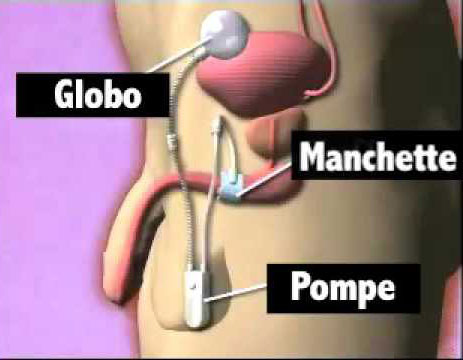Urinary incontinence
Artificial sphincter for urinary incontinence
Urinary incontinence is any uncontrolled leakage of urine. Specialists estimate that there are more than 3 million people affected by urinary incontinence in France.
Men are less affected than women. It is due to the fact that passive continence system is more developed in men than women. It is notably based on the lenght of the urethra (longer in men) and the presence of the prostatic gland at the neck of the bladder which can block the flow of urine as it grows in volume. In addition the men striated sphincter is more powerful than women’s one.
In the great majority of the cases, male incontinence is overflow incontinence due to prostate enlargement. Cases of incontinence related to a sphincter failure are rare and often the consequence of surgical interventions on the prostate or the urinary tract.
The detailed diagnosis that we conduct leads to a customized treatment for each patient based on the therapeutic equipment that we use.
• the urethral cuff: it wraps around your urethra to control the flow of urine.
• the balloon: it holds the same fluid as the cuff. This is where the fluid is moved to when the urethral cuff is open or deflated. It’s placed under the abdominal muscles.
• the pump: it moves fluid into or away from the urethral cuff. It’s placed in the scrotum and it is the only part of the artificial urinary sphincter that you will be able to manipulate.

The surgical process
Meticulous aseptic techniques must be exercised during sphincter implantation. That’s why a sterile bacteriological check-up of the urines will be performed and an antibiotic treatment will start several days before the operation.
The procedure takes place under general anaesthetic or epidural. The 3 parts of the artificial urinary sphincter will be inserted thanks to an horizontal 15 cm incision at the level of the pubic bone.
A catheter will be put in place to ensure the bladder drainage during 24 hours.
Once at home, the urinary incontinence will still be the same as the artificial urinary sphincter will only activated after 4 to 6 weeks.
After these 4 weeks, you will be assisted by a physiotherapist for the first artificial sphincter activation. He will explain to you the way it works and you will manipulate it in front of him. The global functioning is quite easy.
Urethral occlusion is automatically and permanently ensured by the occlusive cuff. When you need to urinate, the cuff of the artificial sphincter can be relaxed. This allows urine to flow out. The cuff will remain open during a few minutes for you to urinate. The urethral cuff then re-inflates automatically to refill the urethral cuff and once again prevent urine from leaking.
Lenght of the stay
2 or 3 days
Activation of the artificial sphincter
After 4 to 6 weeks
Success rate
85 to 100%
Results are quite encouraging as 85 to 100% of the patients are continent thanks to the use of an artificial urinary sphincter. The latter sometimes leads to some infectious complications or one of the parts can erode. In such cases the sphincter has to be removed. The average lifetime of this sphincter is about 10 years. Then its components would need to be replaced.
